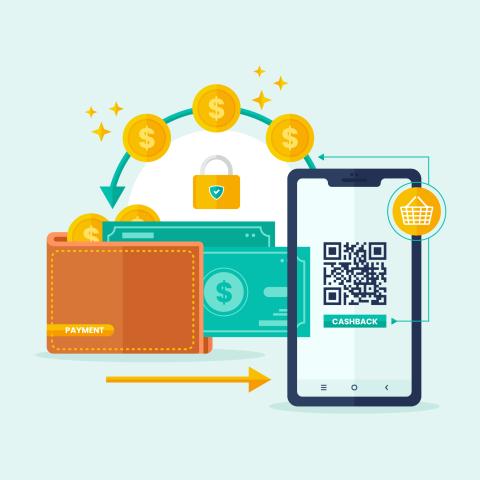We have seen a notable transformation in how we conduct our transactions. Nowadays, traditional means of payment like cash and credit cards are being overshadowed by more sophisticated and secure payment systems that provide ease of use to their users.
Among the platforms leading this change are NFC and QR code payment systems. The e wallet payment system, which employs NFC (Near Field Communication) and QR codes (Quick Response codes), has become a game changer for businesses like yours and your customers who want more effective transactions.
Brief Details of NFC and QR Code Payments
However, they both follow entirely different principles, although they are contactless technologies.
NFC Payments:
With this technology, mobile devices and contactless cards can interact within a few centimeters when near each other. This technology is often found in smartphones for purposes such as access control, payments, or even data exchange. eWallet solutions enable users to perform safe transactions just by tapping their gadgets on terminals that are compatible with the application.
QR Codes Payments:
On the contrary, two-dimensional barcodes that can be scanned using a smartphone camera are called QR codes. As regards payments, scanning a merchant’s displayed QR code or at POS (Point of Sale) system where after the transaction will go via the user’s e-wallet application.
What makes digital wallets so popular?
Digital wallets or e-wallets have become an indispensable part of modern-day payment infrastructure because they represent an easy way of keeping money digitally. E-wallets could contain several credit or debit cards, store rewards points, and manage cryptocurrencies. Several factors have driven the adoption of the wallet payment system:
Convenience: These wallets make it easier for people to pay without having money physically with them since one uses his smartphone, thus avoiding the traditional wallets, which had to be carried everywhere.
Security: For fraud, e-wallet transactions are safe since they are encrypted and use tokenization. Not storing personal or sensitive information in the device used for connections reduces the possibility of hacking.
Speed: NFC and QR code-based contactless payments are faster than conventional methods. This benefits both buyers and sellers by saving their time by reducing queues, leading to improved customer satisfaction.
Comparison between NFC and QR Code Payments
Nonetheless, unique features differentiate these two alternatives for cashless payments.
Payments via NFC:
Speed and Convenience: The speed at which the NFC payment system works is incredible; with only a tap of the device against an NFC-enabled terminal, one’s transaction is completed almost instantly.
Safety: Encryption techniques and tokenization make all transactions through NFC secure. Moreover, due to its limited communication range, data interception by malicious individuals becomes difficult, if not impossible.
User Experience: The user experience that results from using NFC is seamless and easy to understand since no application opening or code scanning is needed, just tap your phone on a receiver.
Cost-Effective: Implementing QR code payments is generally cheaper than NFC because it only requires codes to be printed and a basic scanning device or app.
Accessibility: QR codes are more accessible to a broader range of users and businesses, especially in areas where NFC technology has not yet been adopted.
The Role of NFC and QR Codes in E-Wallet Transactions
a. For Your Business:
There are various benefits that you can stand to enjoy from the adoption of NFC and QR code payment systems, such as:
Increased Sales: Multiple payment options may attract more customers, including those who prefer touchless methods. This adaptability may increase revenue and customer satisfaction.
Enhanced Security: Both technologies provide secure transactions, thereby reducing the risk of fraud and chargebacks, which is essential, primarily if your business handles high volumes of transactions.
Improved Efficiency: Contactless payments accelerate checkout, reducing lines and improving customer flow. In terms of efficiency, this will be essential, particularly in the retail and hospitality sectors.
Data Insights: Digital transactions generate helpful information that companies can use to understand their customer’s behavior, tastes, and preferences for better marketing strategies and improved ways of communicating with customers.
b. For Consumers:
The inclusion of both NFC and QR code technologies into an individual’s e-wallet payment system has positive implications for consumers, such as:
No need to carry cash: This type of payment is convenient because you can pay quickly without having to carry cash or plastic cards around. This is also applicable when buying online stuff.
Security: The advanced security features embedded in these two techniques offer peace of mind, knowing their financial aspects are safeguarded against unauthorized parties like hackers.
Rewards: Several electronic wallets contain many reward programs and discounts that can be accessed and redeemed freely, thus enhancing the overall shopping experience.
The Future of E-Wallet Transactions
The future of e-wallet transactions looks bright, with NFC and QR code payment systems playing a significant role as technology advances. Several trends are expected to define this future:
Widespread Adoption: More businesses and individuals are expected to embrace NFC and QR code systems as they realize the benefits of contactless payments. Technology advancements will propel this growth, increase smartphone penetration rates, and increase the need for hygiene post-COVID-19.
Integration with Emerging Technologies: Blockchain, IoT, AI, and other emerging technologies will allow for the integration of NFCs and codes, making e-wallets more secure and functional. AI can provide personalized shopping experiences, while blockchain can offer enhanced security and transparency.
Global Reach: The global distribution of NFC and QR code payments should help bridge the gap between developed and developing countries so that more people participate in the digital economy, leading to financial inclusion.
Conclusion
The e-wallet payment system is revolutionizing, with NFC and QR code versions changing how transactions are done. With these technologies, you will increase sales, improve safety, increase efficiency, and gain valuable insights based on data. Convenience, security, and access to rewards are what they mean to consumers.
All this change will continue shaping the digital payments field, in which these developments have been widely adopted and have resulted in innovations. To keep up with the fast pace associated with today’s business climate and help preserve their operations for an increasingly digital future, companies should not hesitate to use NFC technology and QR code payments.







